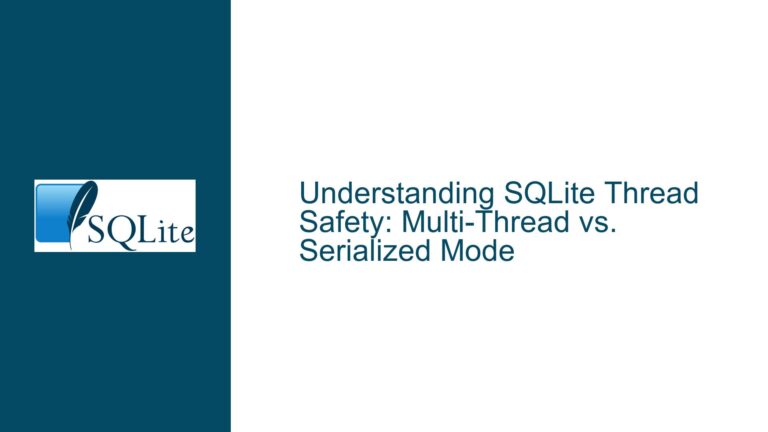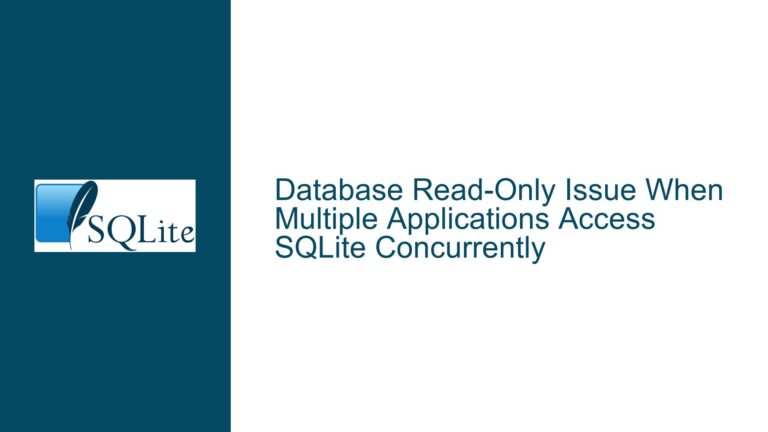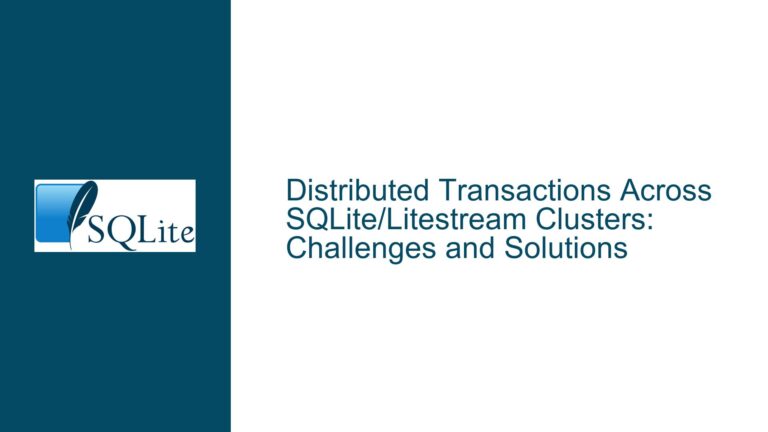Handling Multiple Read and Write Calls in SQLite for Web Services
SQLite Concurrency Challenges in Web Service Environments
SQLite is a lightweight, serverless database engine that is widely used in embedded systems, mobile applications, and small-scale web services. However, its concurrency model can pose challenges when deployed in web service environments where multiple clients may simultaneously attempt to read from and write to the database. SQLite’s default concurrency model allows multiple readers but only one writer at a time, and writes are serialized. This behavior is generally sufficient for low to moderate traffic scenarios, but it can become a bottleneck in high-concurrency environments, especially when the database is accessed over a network.
In web service scenarios, the database is often accessed by multiple clients, some of which may be readers and others writers. Readers typically require real-time access to the data, while writers may tolerate some delay but require reliability. The primary challenge is to ensure that reads are not blocked by writes and that writes are executed reliably, even under heavy load. SQLite’s Write-Ahead Logging (WAL) mode can help improve concurrency, but it has limitations, particularly when the database is accessed over a network.
The core issue revolves around implementing a concurrency model that supports multiple concurrent reads and serialized writes without compromising reliability. This requires a deep understanding of SQLite’s concurrency mechanisms, the implications of using WAL mode, and the potential pitfalls of network-based access. Additionally, it is essential to consider how to handle scenarios where the system is overloaded, as this can lead to timeouts and data loss if not managed properly.
Interrupted Write Operations and Network Access Limitations
One of the primary causes of concurrency issues in SQLite when used in web services is the interruption of write operations. SQLite uses a file-based locking mechanism to manage concurrency. When a write operation is initiated, SQLite acquires an exclusive lock on the database file. If another process attempts to write to the database while the lock is held, it will be blocked until the lock is released. This can lead to delays and timeouts, especially in high-concurrency environments.
The use of WAL mode can mitigate some of these issues by allowing readers to continue accessing the database while a write operation is in progress. However, WAL mode has its limitations. Specifically, WAL mode is designed to work efficiently only when all processes accessing the database are on the same host. When the database is accessed over a network, the benefits of WAL mode are significantly reduced. This is because network file systems often do not support the same locking mechanisms as local file systems, leading to potential inconsistencies and performance degradation.
Another cause of concurrency issues is the lack of proper timeout settings. SQLite provides a busy timeout mechanism that allows a process to wait for a specified amount of time before giving up on acquiring a lock. If the timeout is set too low, write operations may fail prematurely, leading to data loss. Conversely, if the timeout is set too high, the system may become unresponsive under heavy load, effectively resulting in a denial-of-service (DoS) condition.
Implementing WAL Mode and Busy Timeouts for Reliable Writes
To address the concurrency challenges in SQLite for web services, it is essential to implement a combination of WAL mode and appropriate busy timeout settings. WAL mode can be enabled by executing the following SQL command:
PRAGMA journal_mode=WAL;
Enabling WAL mode allows multiple readers to access the database simultaneously while a write operation is in progress. This can significantly improve read performance in high-concurrency environments. However, as previously mentioned, WAL mode is most effective when all processes accessing the database are on the same host. When the database is accessed over a network, additional considerations are necessary.
One approach to mitigating the limitations of WAL mode in network environments is to use a proxy or middleware layer that coordinates access to the SQLite database. This layer can be implemented using a web server or a custom application that manages database connections and ensures that write operations are serialized. The middleware layer can also handle retries and timeouts, ensuring that write operations are reliably executed even under heavy load.
In addition to enabling WAL mode, it is crucial to set appropriate busy timeout values. SQLite’s busy timeout can be set using the following command:
PRAGMA busy_timeout=<timeout_in_milliseconds>;
The busy timeout should be set to a value that balances the need for reliability with the need to avoid system unresponsiveness. A timeout value of 5000 milliseconds (5 seconds) is often a good starting point, but this may need to be adjusted based on the specific requirements of the application and the expected load.
To further enhance reliability, it is recommended to implement a queueing mechanism for write operations. This can be done at the application level, where write requests are placed in a queue and processed sequentially. The queue can be implemented using a variety of technologies, such as a message queue or a simple in-memory queue. By serializing write operations, the application can ensure that writes are executed reliably, even when the system is under heavy load.
Finally, it is essential to monitor the performance of the SQLite database and adjust the configuration as needed. This includes monitoring the number of concurrent connections, the frequency of timeouts, and the overall response time of the database. Tools such as SQLite’s built-in performance profiling and logging features can be used to gather this information and identify potential bottlenecks.
In conclusion, handling multiple read and write calls in SQLite for web services requires a combination of WAL mode, appropriate busy timeout settings, and a queueing mechanism for write operations. By carefully configuring these elements and monitoring the performance of the database, it is possible to achieve a high level of concurrency and reliability, even in high-traffic environments.






